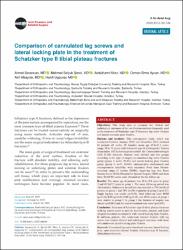| dc.contributor.author | Sevencan, Ahmet | |
| dc.contributor.author | Şenol, Mehmet Selçuk | |
| dc.contributor.author | Mısır, Abdülhamit | |
| dc.contributor.author | Aycan, Osman Emre | |
| dc.contributor.author | Albayrak, Akif | |
| dc.contributor.author | Uçpunar, Hanifi | |
| dc.date.accessioned | 2020-12-19T20:42:49Z | |
| dc.date.available | 2020-12-19T20:42:49Z | |
| dc.date.issued | 2020 | |
| dc.identifier.citation | Sevencan, A., Şenol, M.S., Mısır, A., Aycan, O.E., Albayrak, A., Uçpunar, H. (2020). Comparison of cannulated lag screws and lateral locking plate in the treatment of Schatzker type II tibial plateau fractures. Joint Diseases and Related Surgery, 31(1), 130-136. | |
| dc.identifier.issn | 2687-4784 | |
| dc.identifier.issn | 2687-4792 | |
| dc.identifier.uri | https://doi.org/10.5606/ehc.2020.66654 | |
| dc.identifier.uri | https://app.trdizin.gov.tr/makale/TXpZM09UYzFOUT09 | |
| dc.identifier.uri | https://hdl.handle.net/11436/5781 | |
| dc.description.abstract | Objectives: This study aims to compare the clinical and radiological outcomes of the two fixation methods frequently used in the treatment of Schatzker type II fractures: lag screw fixation and lateral anatomic plate fixation. Patients and methods: This retrospective study, which was conducted between January 2005 and December 2014, included 61 patients (41 males, 20 females; mean age 43.4±13.1 years; range, 20 to 76 years) with Schatzker type II (Orthopaedic Trauma Association (OTA)/Arbeitsgemeinschaft für Osteosynthesefragen (AO) 41-B3) fractures. Patients were divided into two groups according to the type of surgery as cannulated lag screw fixation group (group 1, n=24, 39.4%) and lateral locking plate fixation group (group 2, n=37, 60.6%). Intraoperative mediolateral and anteroposterior instability were measured. Final knee flexionextention range of motion (ROM), single-leg hop test, Knee Society Score (KSS), Hospital for Special Surgery (HSS) and short form 36 (SF36) scores were obtained at the last follow-up. Results: The mean age of patients was 42.1±13.8 years in group 2 and 45.5±12.2 years in group 1. The mean follow-up period was 34±4 months. Minimal or no arthritis was detected in 75% (n=18) of patients in group 1 and 78% (n=29) of patients in group 2 (p=0.27). Single leg-hop test results (p=0.55), final follow-up knee ROM (p=0.40), KSS (p=0.21), HSS (p=0.15), and SF36 scores of group 1 were similar to group 2. In group 1, the duration of surgery was shorter (p<0.001) and the cost of treatment was lower (p<0.001). Conclusion: Treatment of Schatzker type II tibial plateau fractures with lag screws seems to provide less invasive, cheaper, and faster surgical treatment as compared with lateral locking plate fixation. In addition, patients who underwent internal fixation with lag screws had similar clinical and radiological outcomes with those who underwent lateral locking plate fixation. | en_US |
| dc.language.iso | eng | en_US |
| dc.rights | info:eu-repo/semantics/openAccess | en_US |
| dc.subject | Cannulated Lag Screw | en_US |
| dc.subject | Functional Outcome | en_US |
| dc.subject | Lateral Locking Plate | en_US |
| dc.subject | Open Reduction Internal Fixation | en_US |
| dc.subject | Schatzker Type II Fractures | en_US |
| dc.subject | Tibial Plateau Fractures | en_US |
| dc.title | Comparison of cannulated lag screws and lateral locking plate in the treatment of Schatzker type II tibial plateau fractures | en_US |
| dc.type | article | en_US |
| dc.contributor.department | RTEÜ, Tıp Fakültesi, Cerrahi Tıp Bilimleri Bölümü | en_US |
| dc.contributor.institutionauthor | Sevencan, Ahmet | |
| dc.identifier.doi | 10.5606/ehc.2020.66654 | |
| dc.identifier.volume | 31 | en_US |
| dc.identifier.issue | 1 | en_US |
| dc.identifier.startpage | 130 | en_US |
| dc.identifier.endpage | 136 | en_US |
| dc.ri.edit | oa | en_US |
| dc.relation.journal | Joint Diseases and Related Surgery | en_US |
| dc.relation.publicationcategory | Makale - Uluslararası Hakemli Dergi - Kurum Öğretim Elemanı | en_US |


















